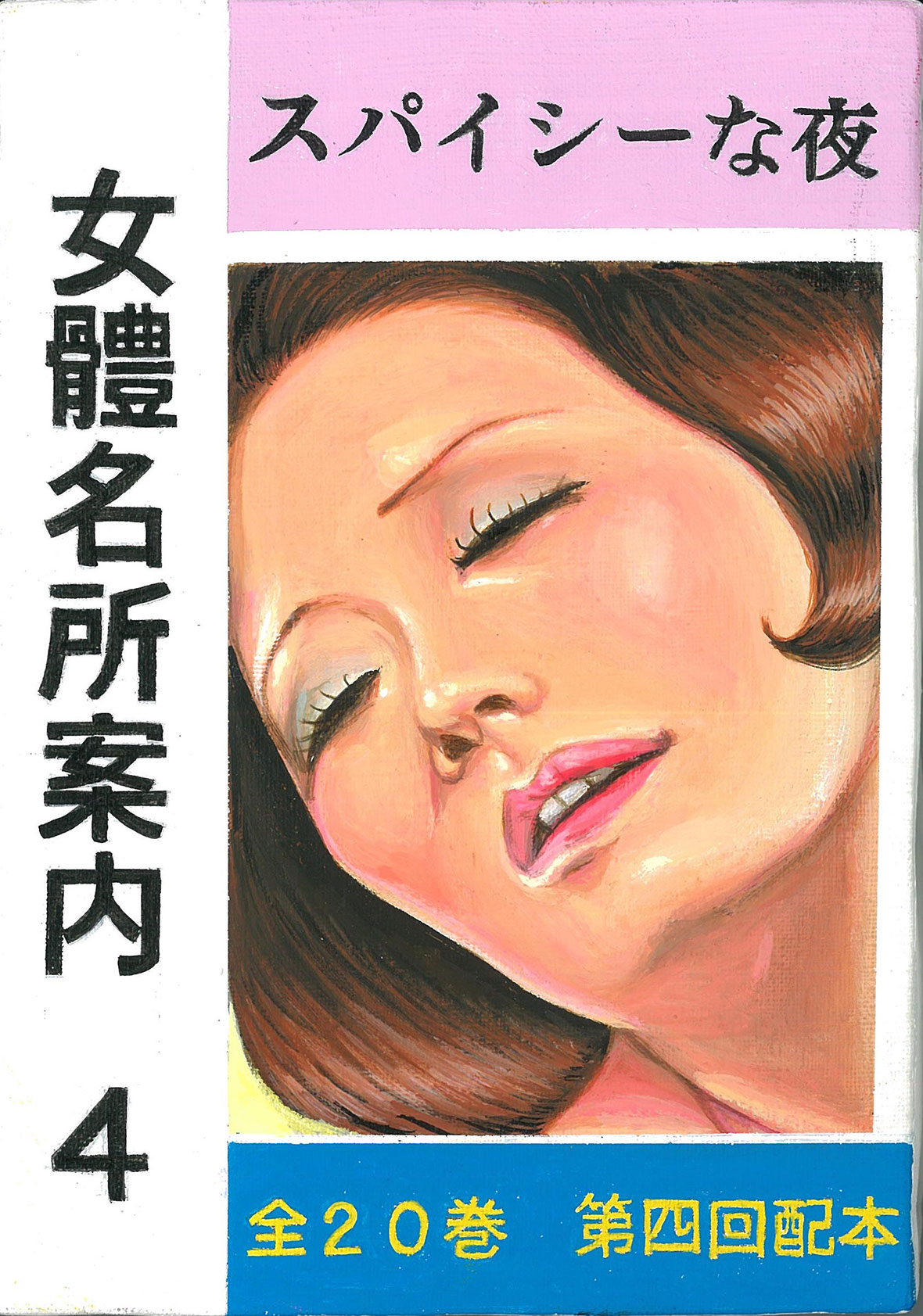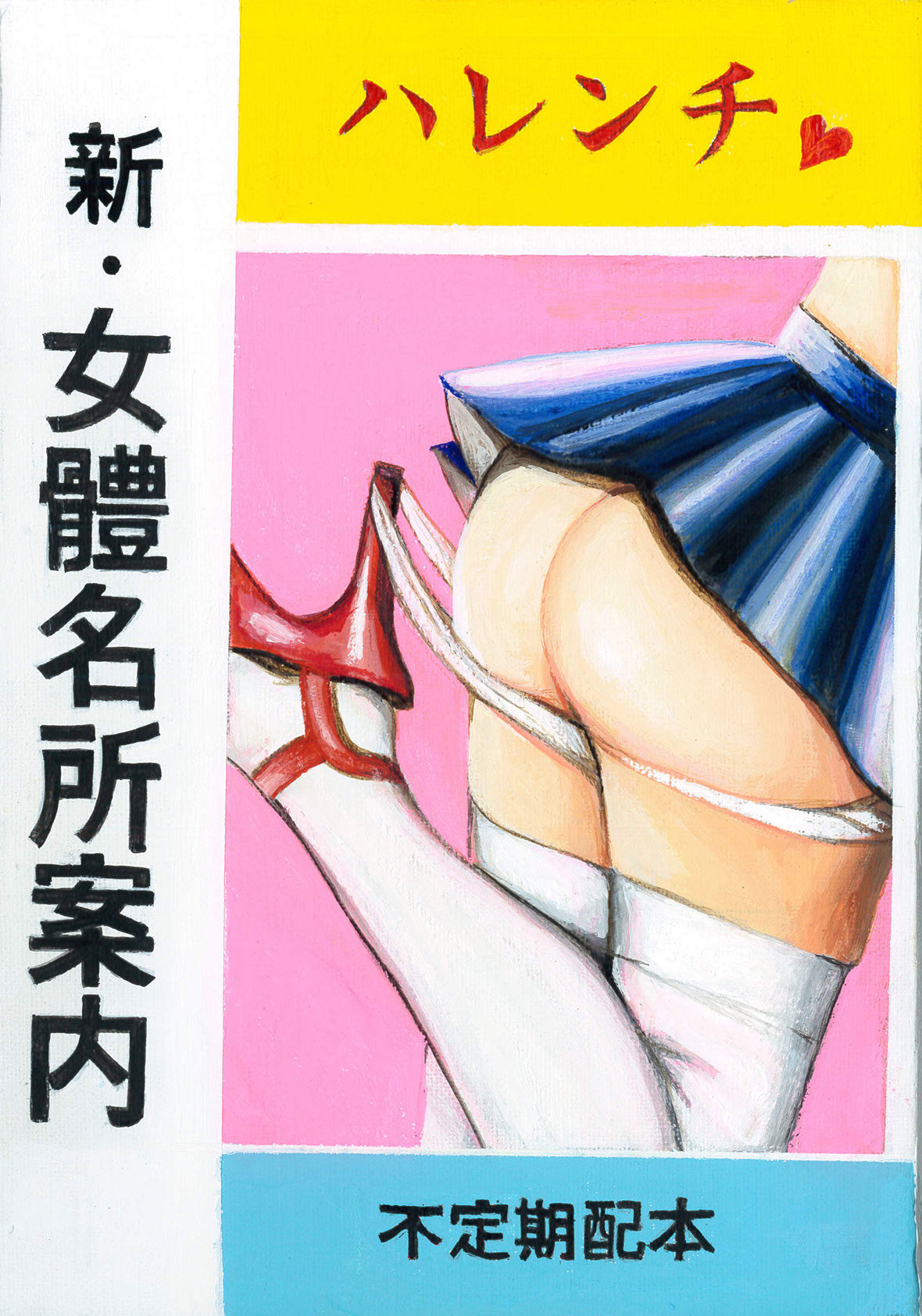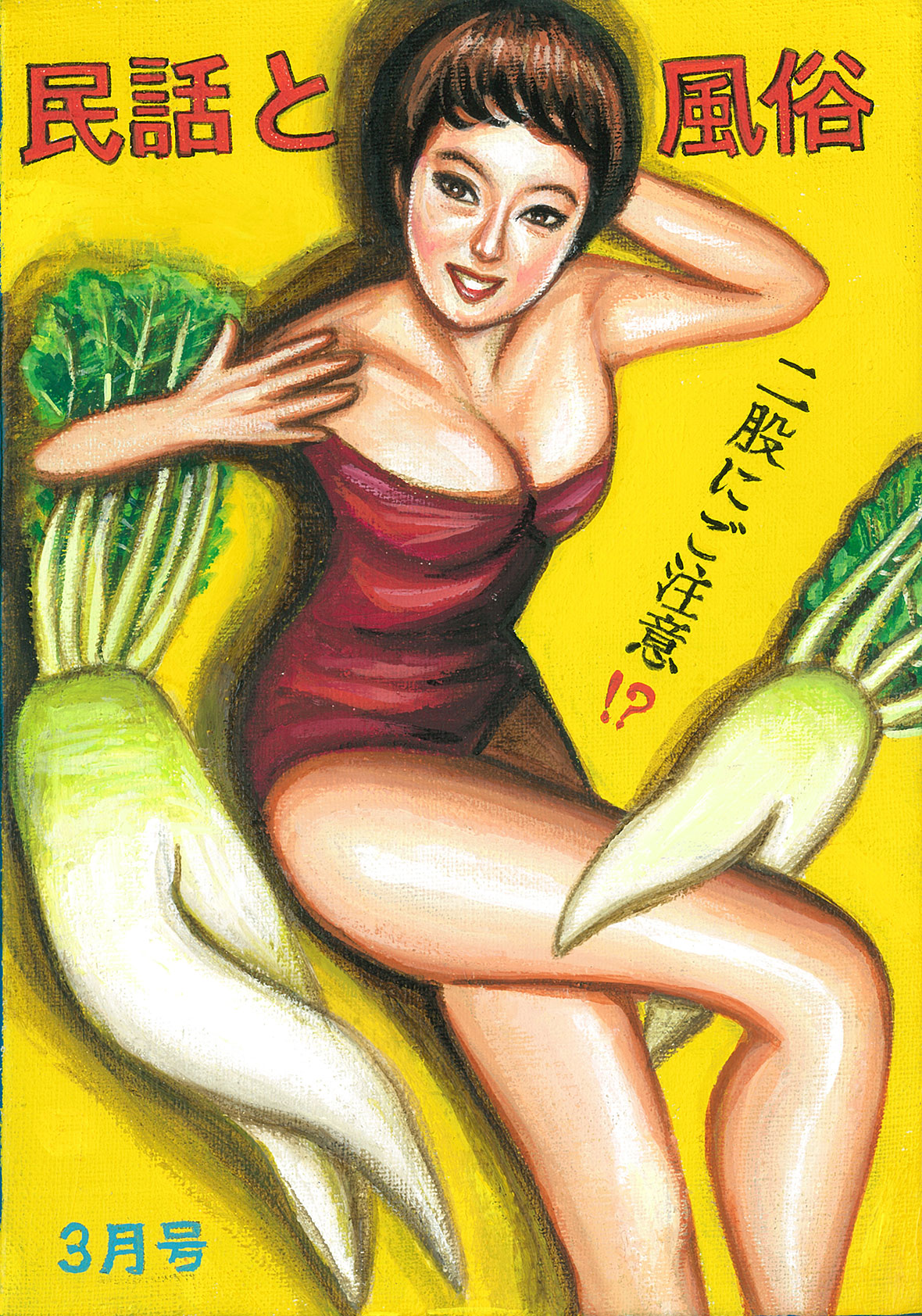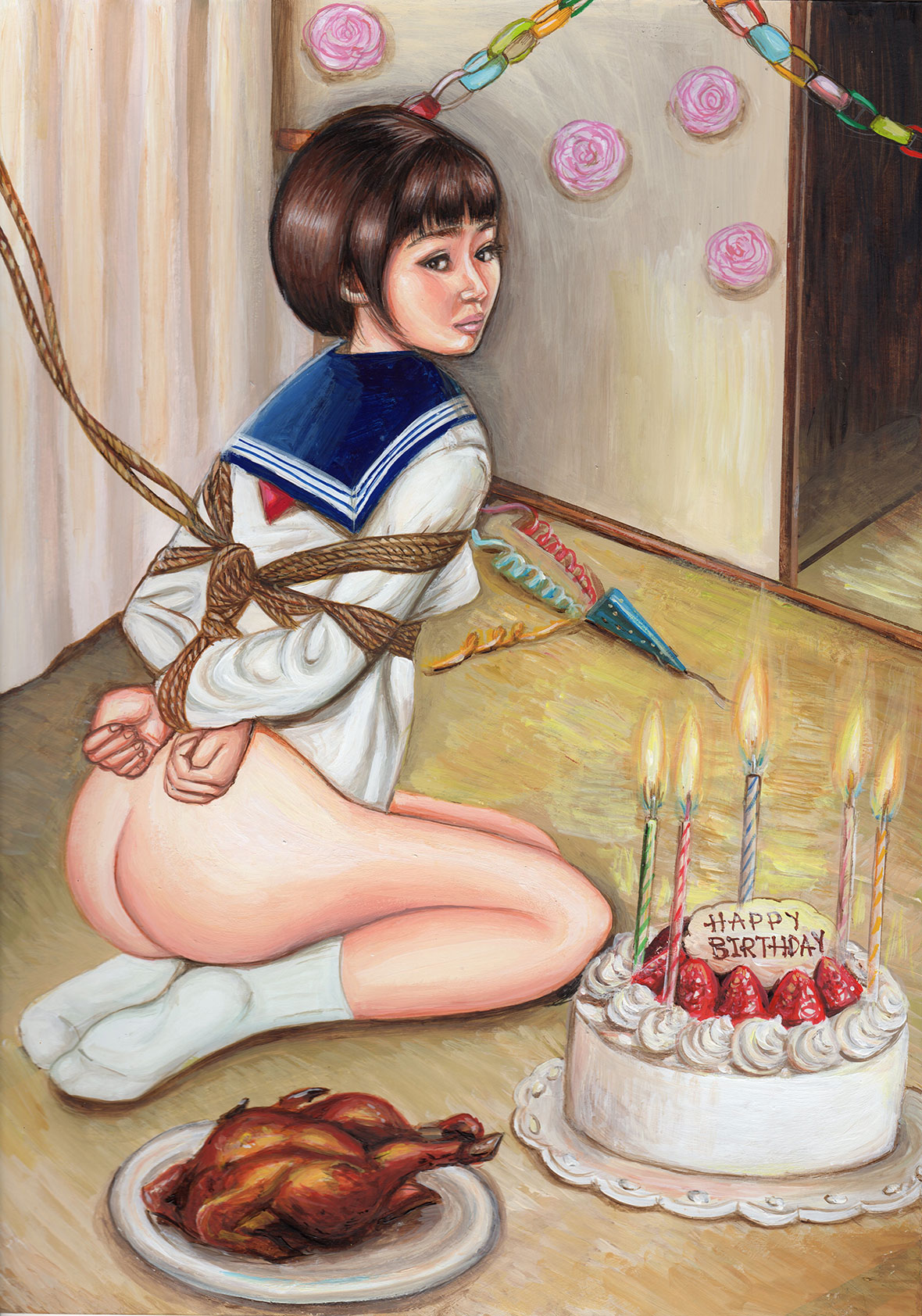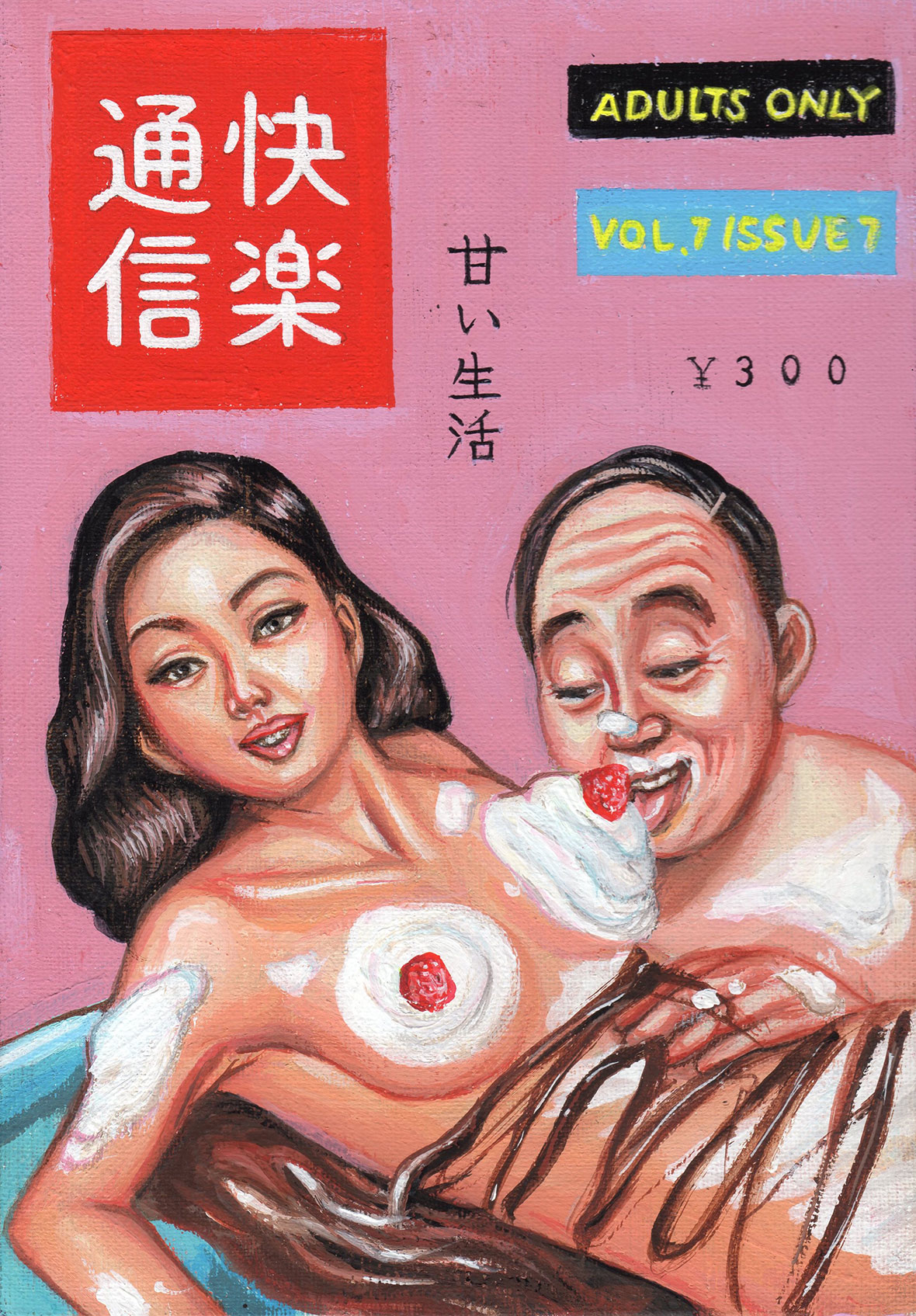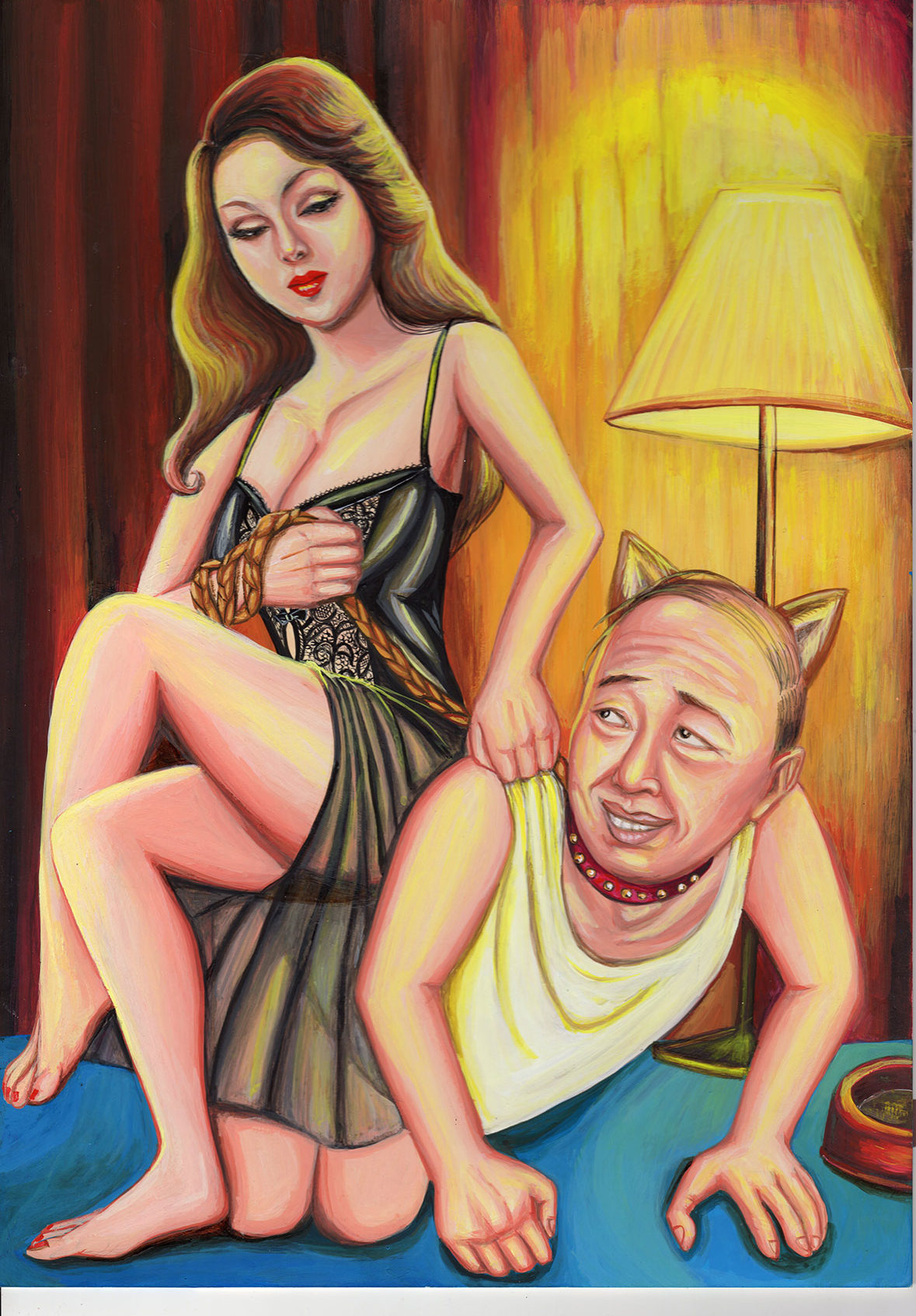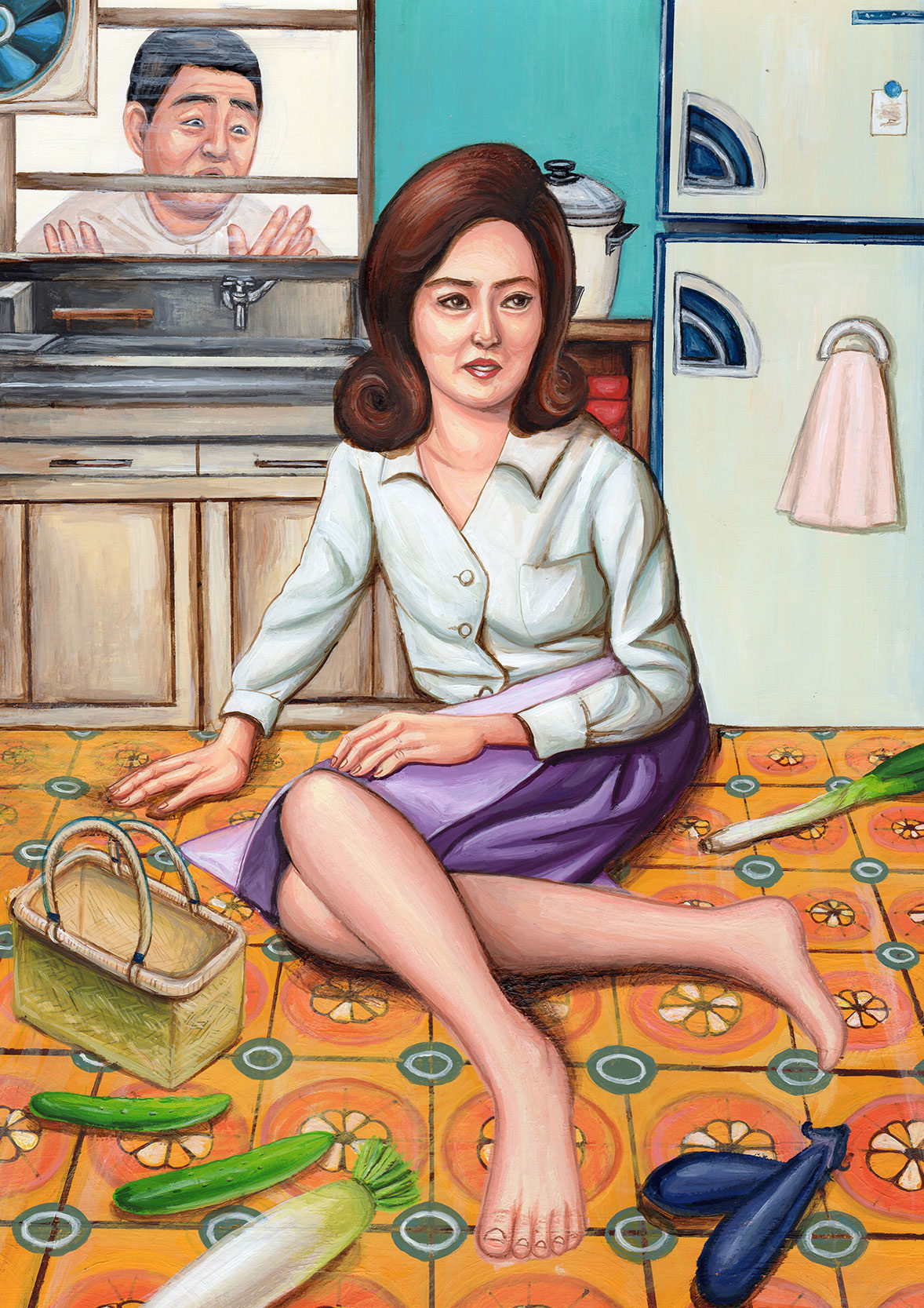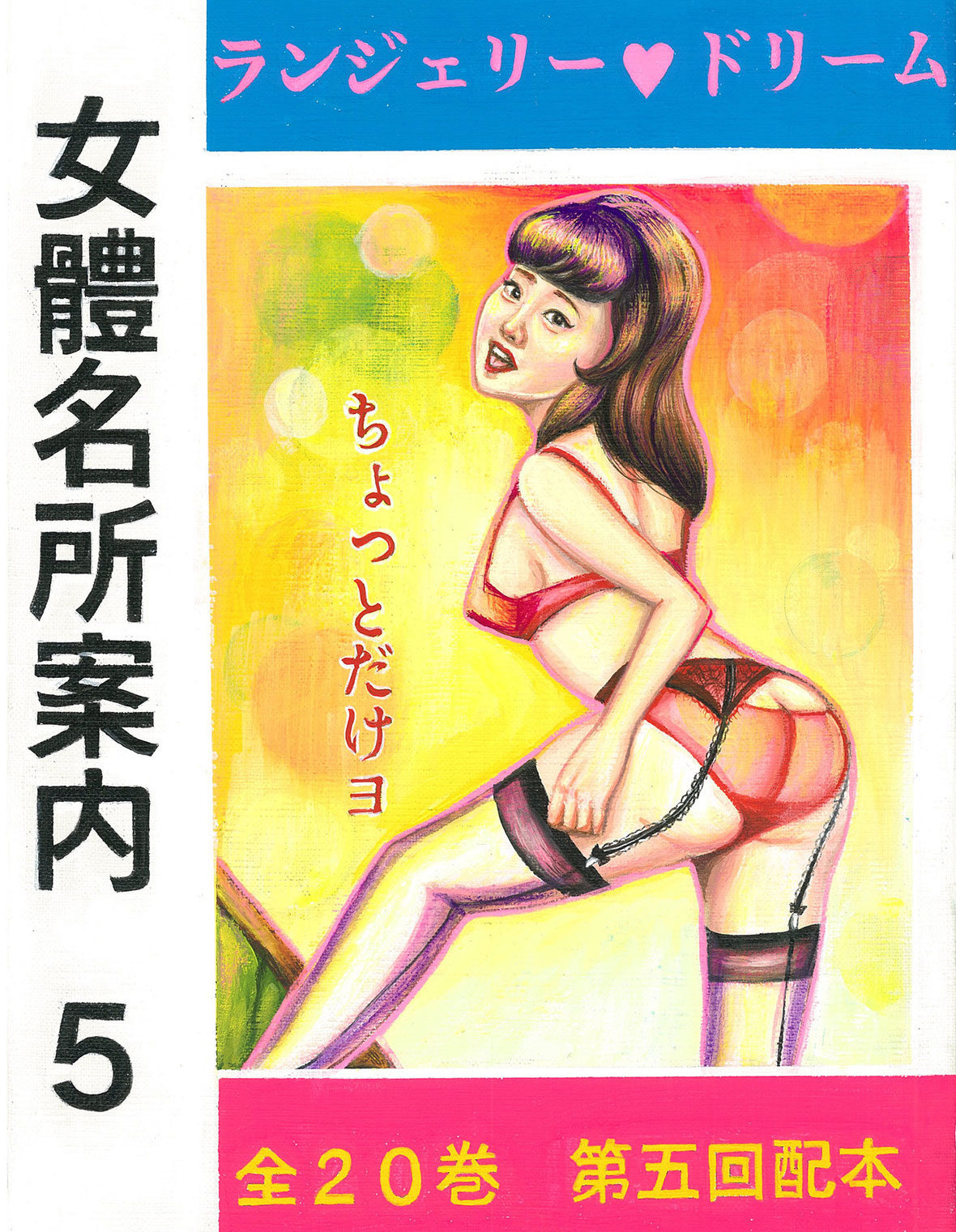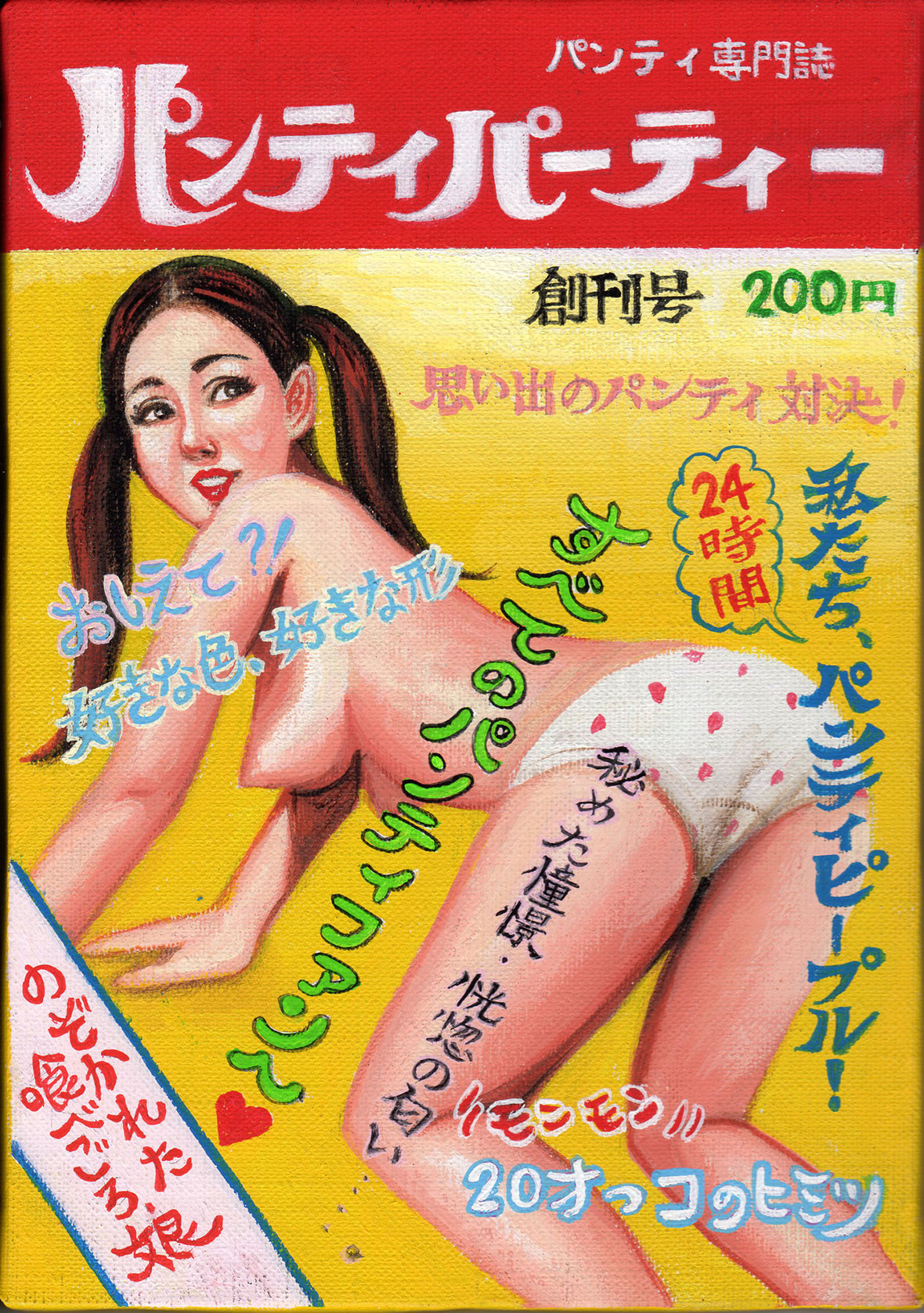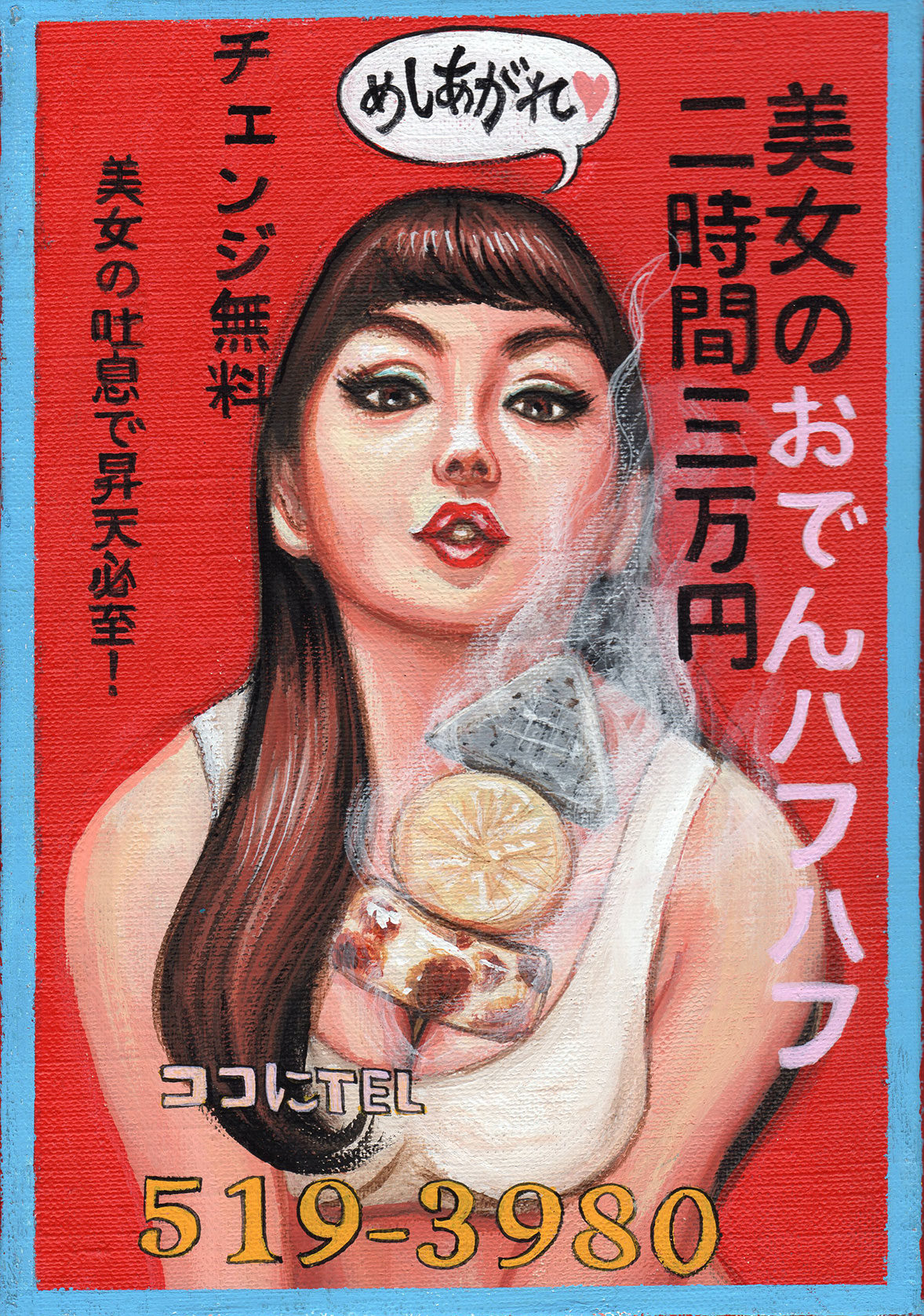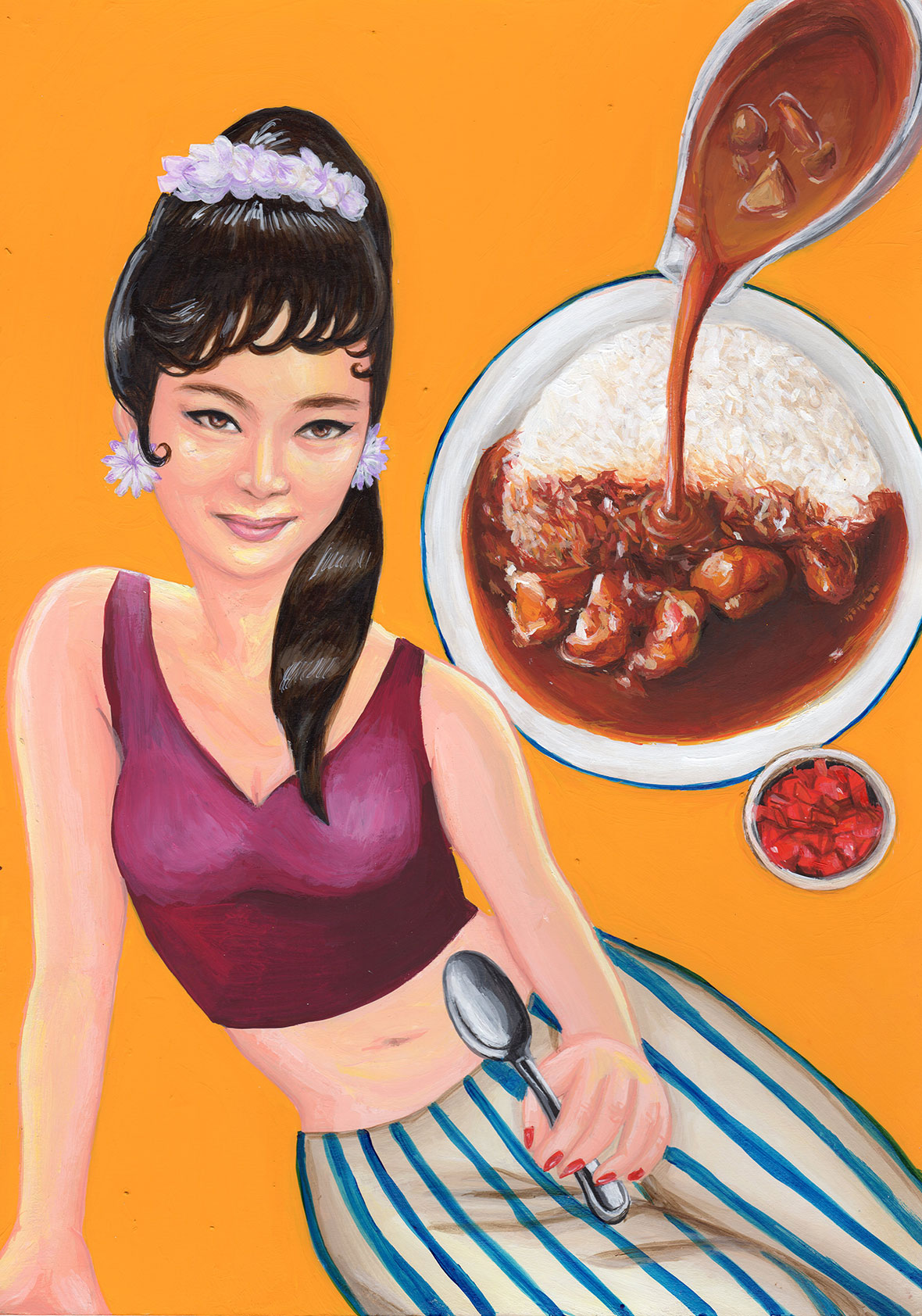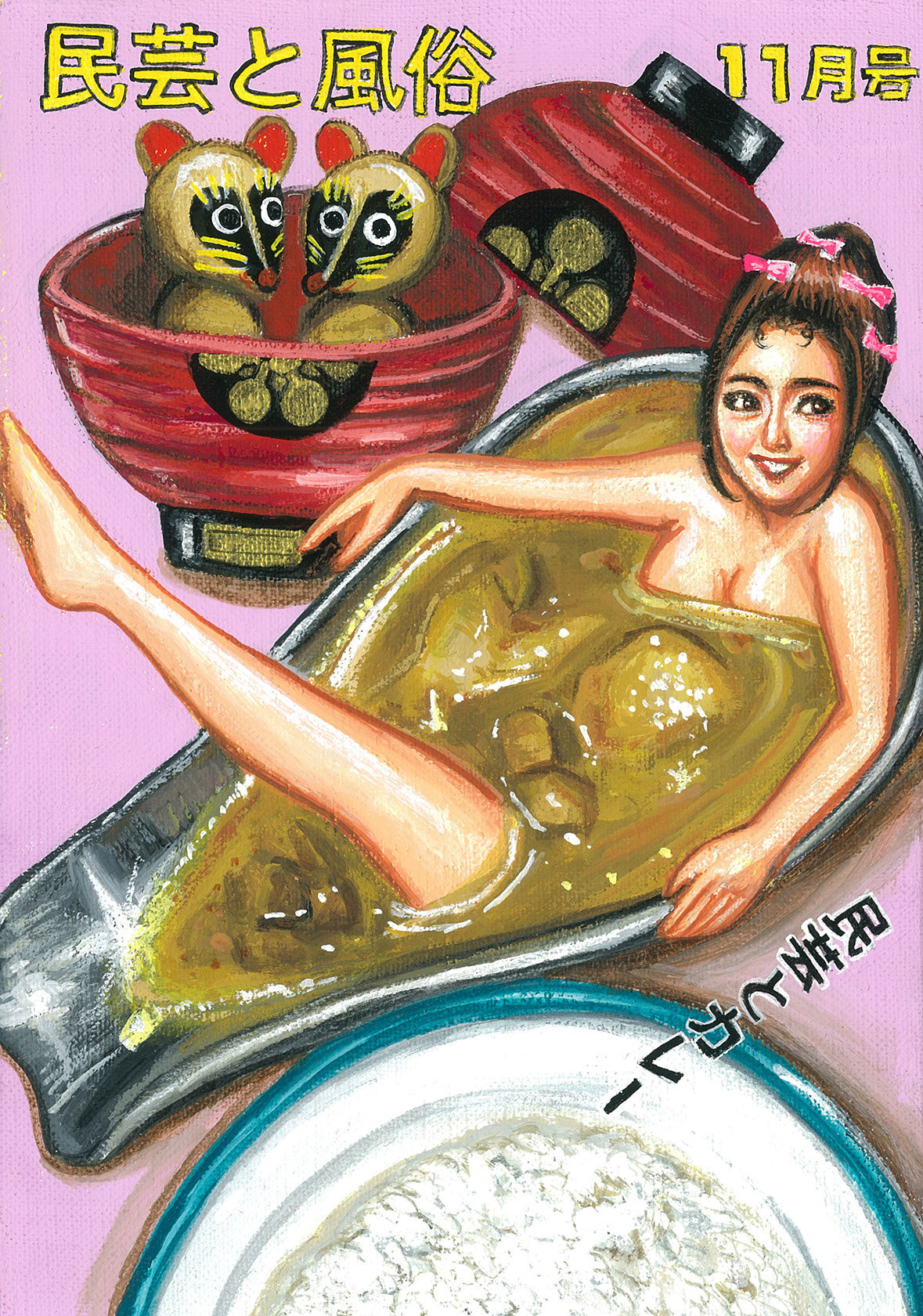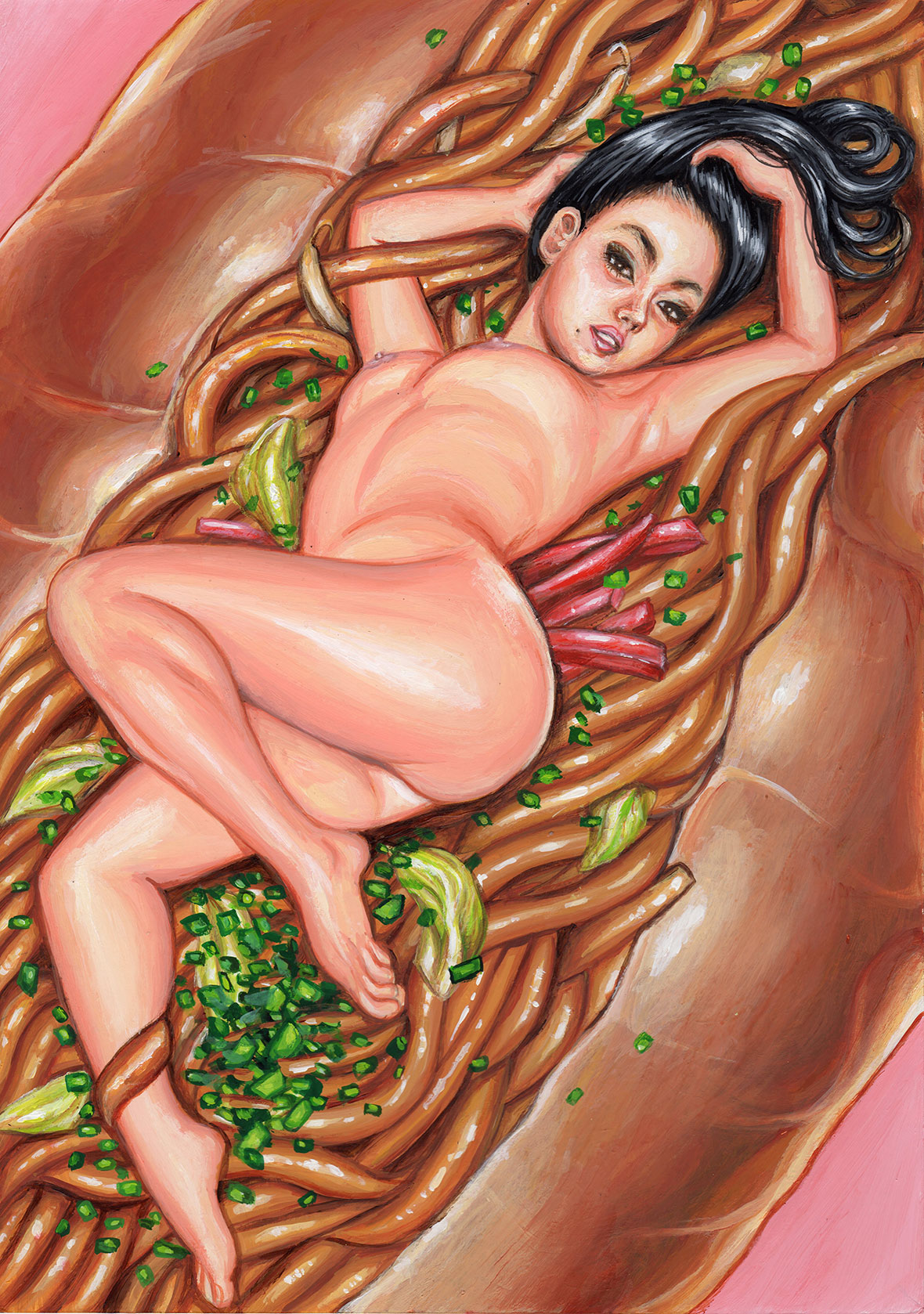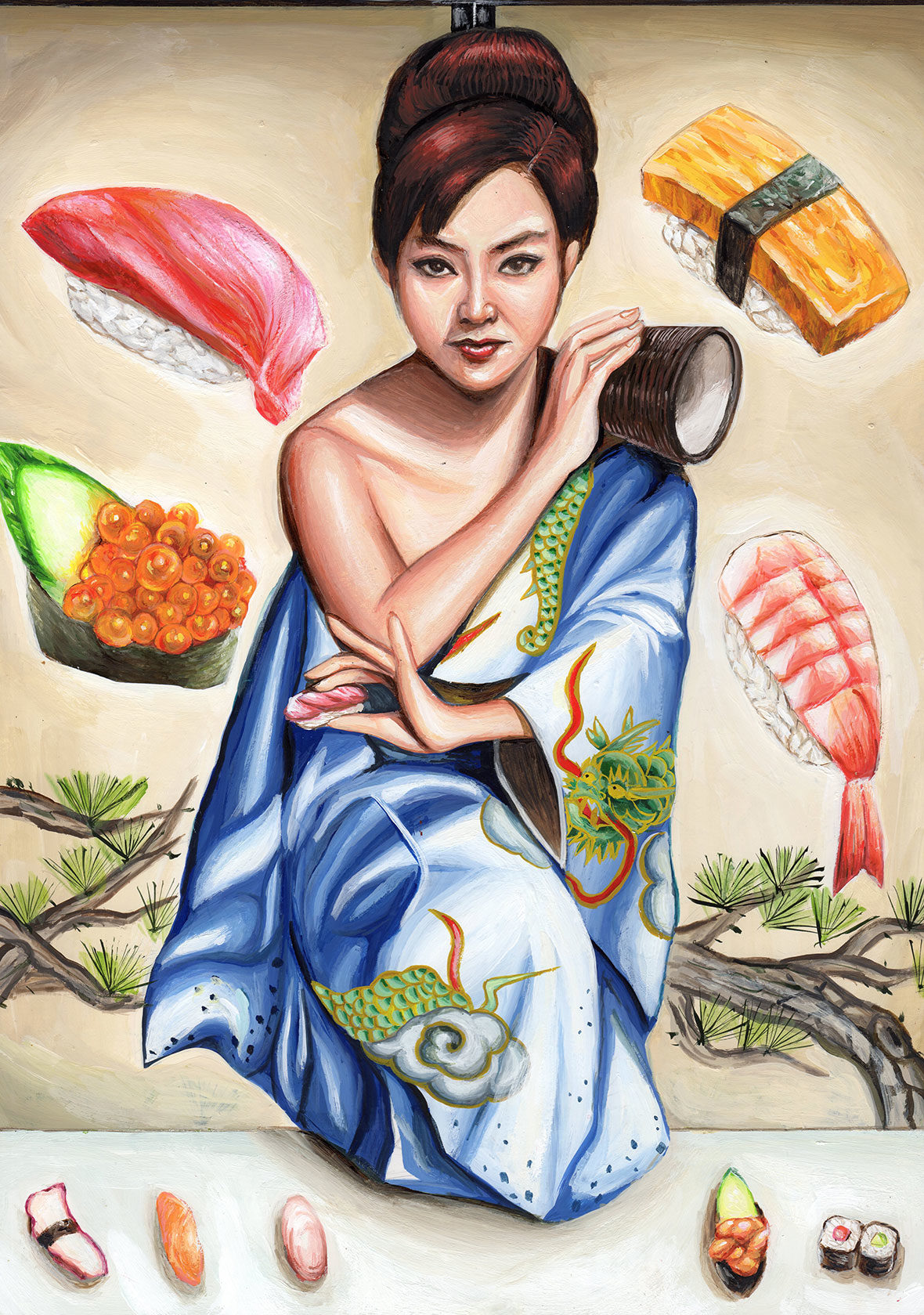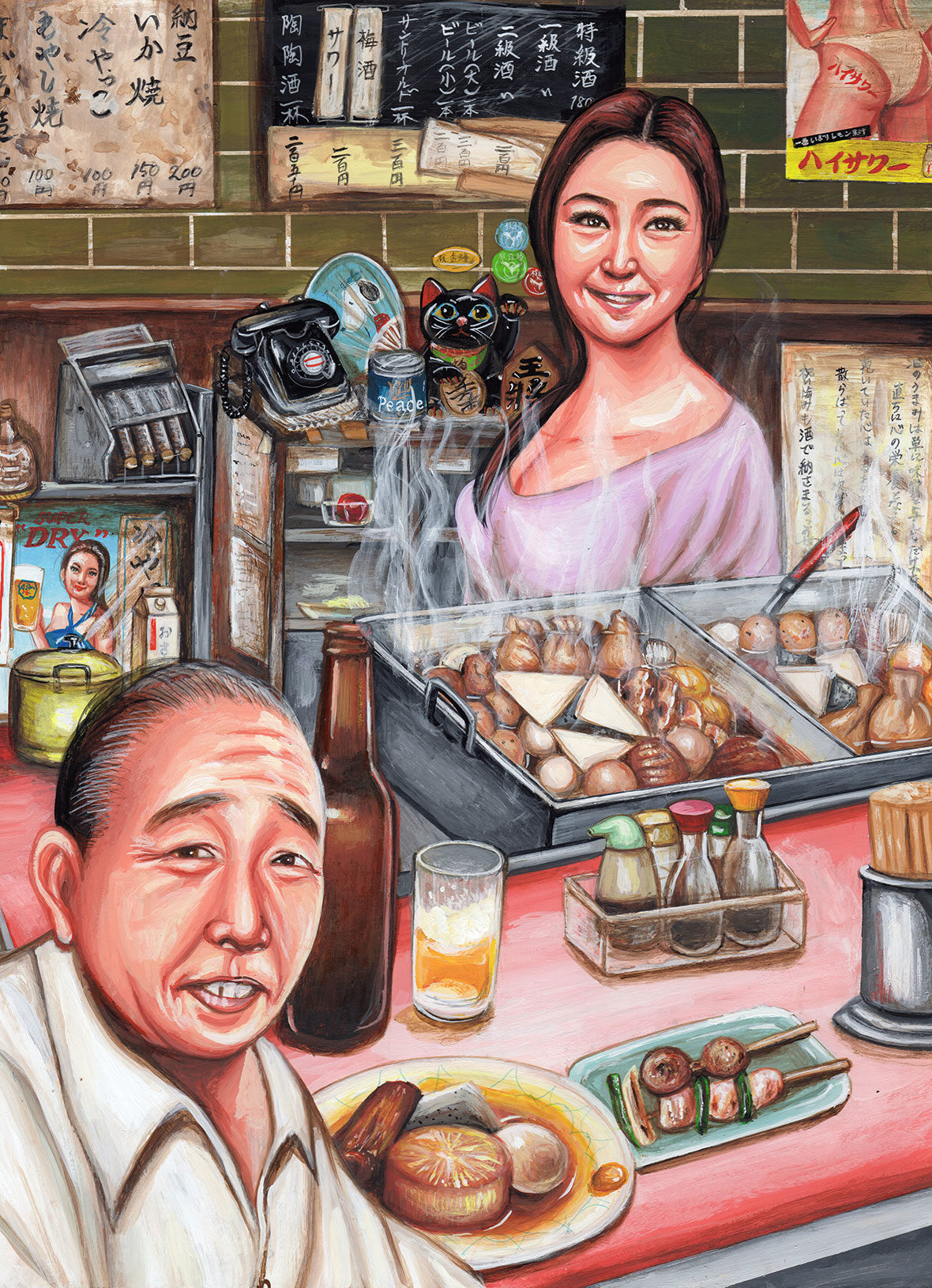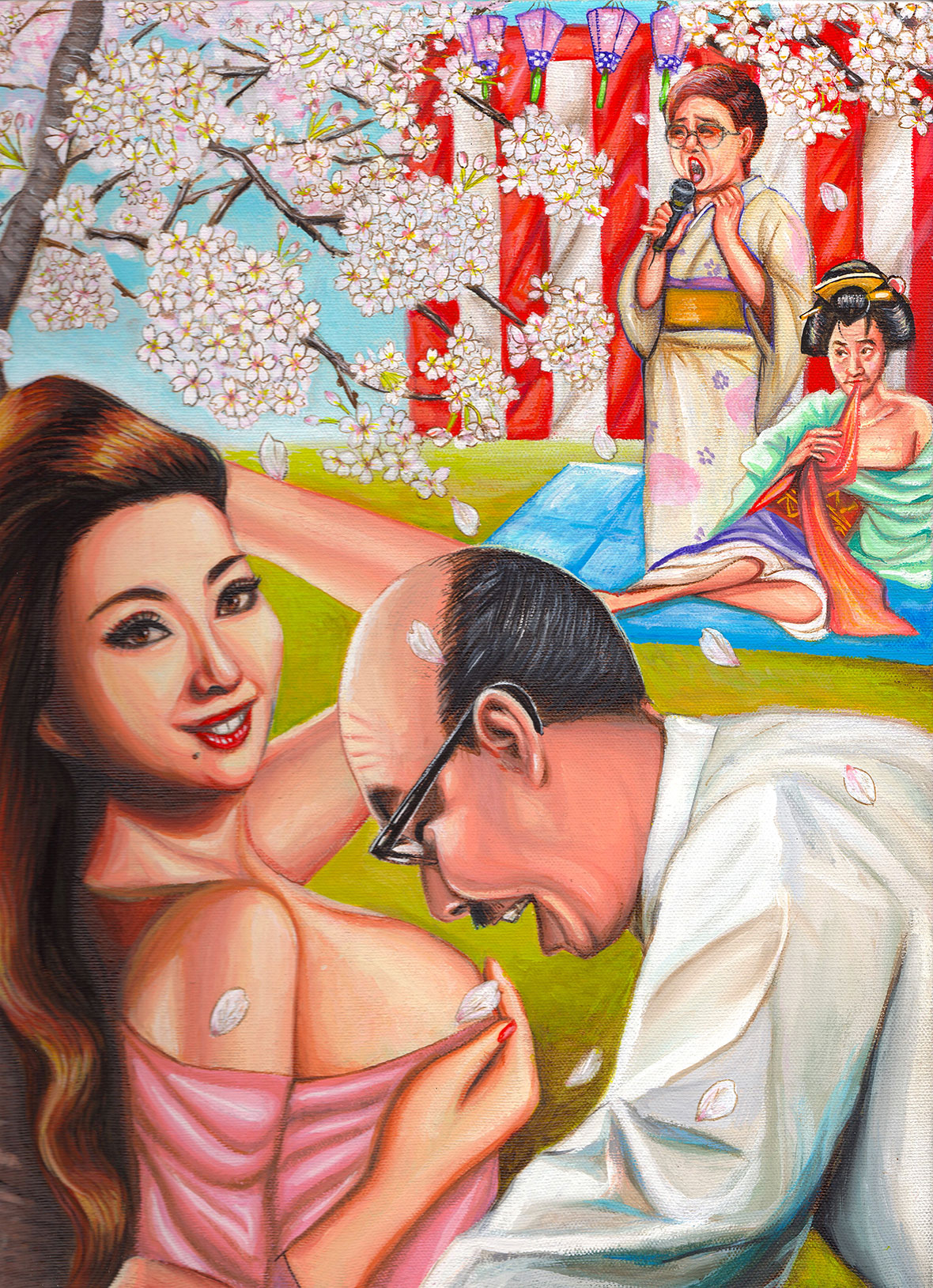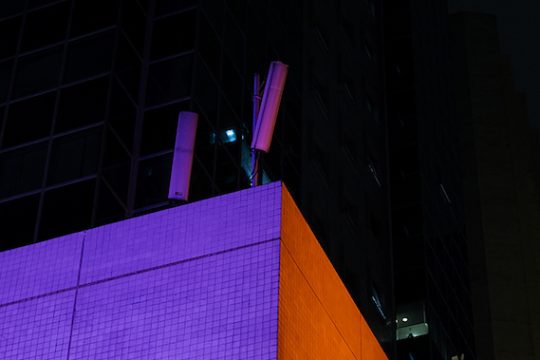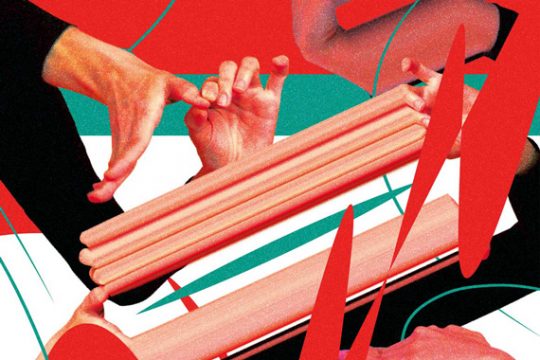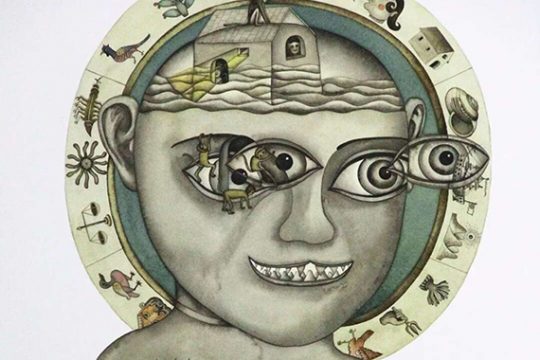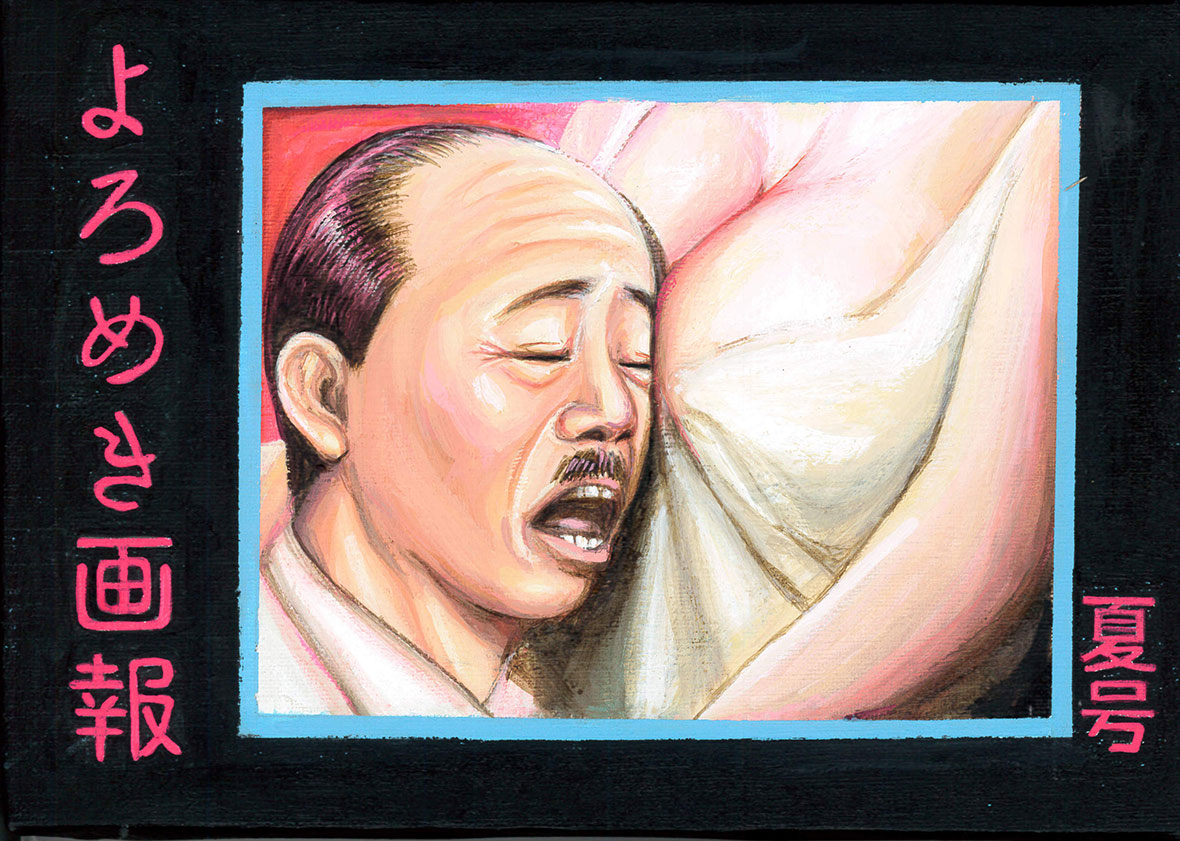
The Showa Era is a fascinating time in Japanese history. Spanning from 1926 to 1989, the length of the reign of Emperor Hirohito, the period comprises the so-called post-war miracle, when Japanese society modernized and westernized. Japanese people gained access to new technologies and household appliances and fully embraced pop culture.
Going to the movies became popular, as did listening to music and sports on the radio. People began gathering in new restaurants and bars. Japan saw the proliferation of fast-food chains and konbinis, iconic convenience stores like Family Mart and Lawsons, with their shelves packed with consumer goods. Cooking became more efficient at home, too; easy meal options included instant noodles and frozen food.
Born in 1977, artist Rina Yoshioka only lived through the tail end of the Showa Era, but her fascination with the period is such that she made it the overlying theme of her work. Painting on canvas, wooden panels, and paper with acrylic gouache, Yoshioka recreates the Showa zeitgeist in garish illustrations of urban and domestic scenes, all featuring women as central figures.
昭和时代在日本历史中是独特的存在。1926 年至 1989 年裕仁天皇在位期间,日本社会实现了现代化、西化,及战后重建。日本民众开始接触新技术和现代家电,并完全接纳了流行文化的洗礼。
电影院、餐馆和酒吧聚会成为人们新的生活方式;音乐和运动类的广播节目开始流行;而随着快餐连锁店和便利店概念的普及,全家(Family Mart)和罗森(LAWSON)等驰名商标纷纷亮相;方便面和冷冻食品的兴起也让做饭这件事变得简单起来。
出生于 1977 年的艺术家吉冈里奈(Rina Yoshioka)正好赶上昭和时代末期。她对这一时期极为迷恋,并将其作为主题进行创作。她的作品中,女性被视作主体。她以帆布、木板和丙烯酸水粉纸上,描绘着一幅幅奢淫的都市场景,展示着昭和时代下社会的思潮。
When looking at her work, viewers might feel like her sense of perspective and scale is slightly off. That’s not something intentional but an accidental consequence of her manual process. Whatever the result is, she embraces it. Yoshioka’s work has a low-brow, kitschy style, similar to the iconography of cheap graphic novels and vintage Bollywood posters. “I’ve always liked the coolness of the analog era and the rough atmosphere Japan had during the Showa period,” she says, adding that anything “vivid and fluffy” attracts her.
也许不难发现,吉冈里奈的作品偶尔会出现视角比例上的失调,这并非有意而为,而是她保留了手绘过程中的偏差,保留作品最原始的状态。她的作品,往往带给观众一种浅薄、媚俗的感受,类似于廉价漫画和早期宝莱坞海报。“我一直着迷于上世纪末‘大哥大时代’的那种酷酷的感觉,以及昭和年间日本文化领域的那种粗糙、原始感”,她解释道。此外,生活中任何“色泽鲜艳、质感毛茸”的事物也都令她着迷。
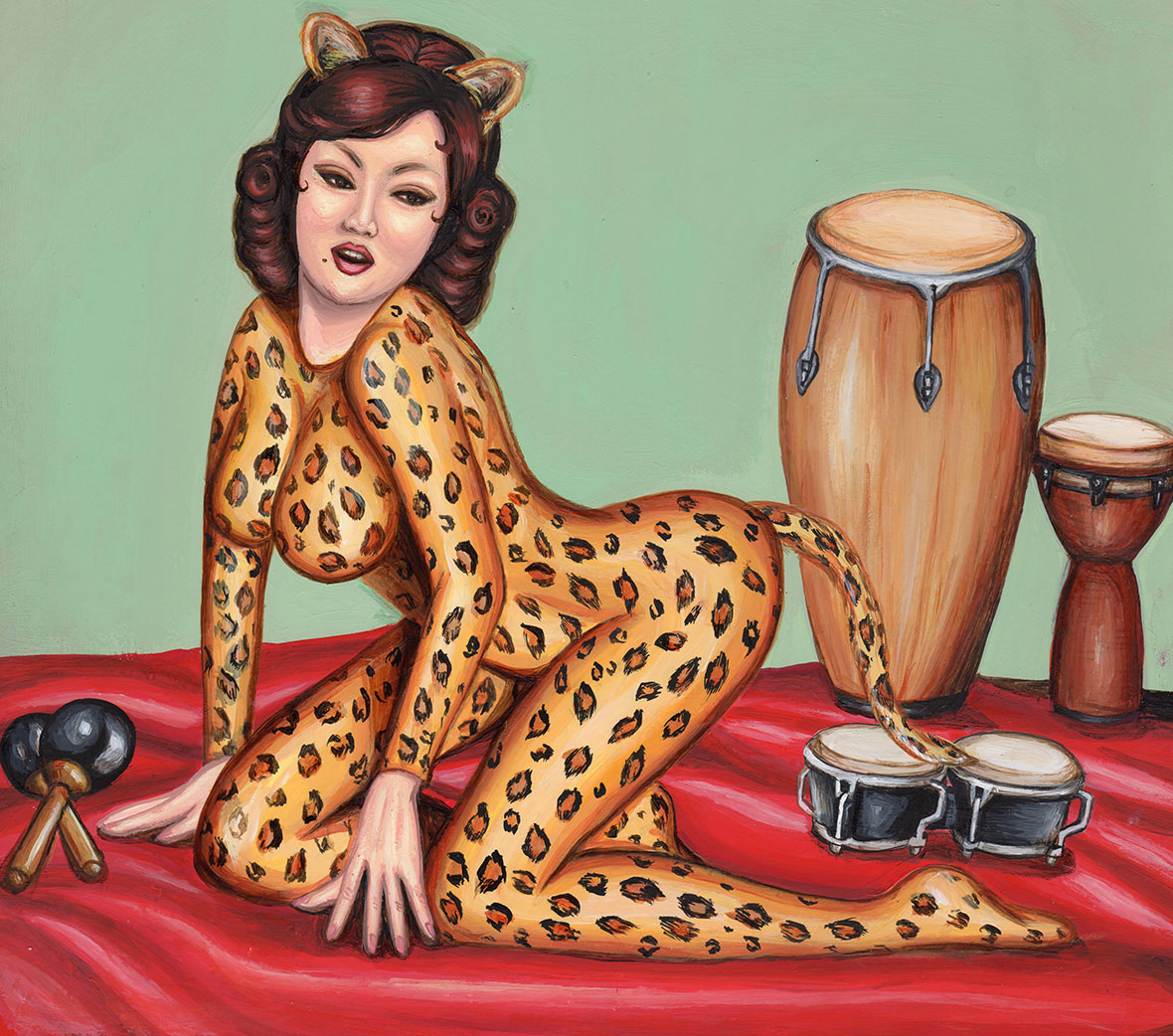
Something else stands out in the scenes she depicts: her female characters appear objectified, in BDSM roles, as sex workers, strippers, hostesses, or housewives, for instance. They pose to satisfy or entice the male gaze or else they’re involved in sexual adventures, sometimes quite sordid.
在吉冈里奈所描绘的场景中,有一个视觉主题格外引人注目,即被物化的女性。她们或成为 BDSM 对象、性工作者,或是脱衣舞女、歌伎或家庭主妇,纷纷搔首弄姿来满足或吸引男性的目光;有时她们会尝试大胆的性探索,其中一些场面相当露骨。
The Showa years also had their kinky side. It was the boom of brothels, love hotels, adult magazines, and the pinku eiga, a low-budget genre of soft-core porn films also known as pink films. The latter two exhibited high levels of toxic masculinity and the obvious sexploitation of women with romantic, comedic, or sadistic overtones.
Adult magazines were sold openly, often in konbinis, and pink films were commonly screened across erotic cinemas in central locations, despite being an embarrassment to serious Japanese directors. To Yoshioka, there’s an obvious difference in how people perceived sexual themes then and now. “I think the Showa Era was more vulgar and obscene, and there was a much more defined separation between the roles of men and women,” she says.
昭和岁月也有其情色的一面,在当时,妓院、爱情旅馆、成人杂志和桃色电影(Pinku Eiga,一种低成本的软色情电影,也被称为粉色电影)势头正旺,充斥着过激的以男性为主的审美,对女性的剥削十分明显。这些内容被包装成浪漫故事、喜剧或虐待情节。
当时,成人杂志在便利店公开出售;桃色电影也常常在中心地段的影院内放映,引发争议。在里奈看来,当时的民众和现在相比,对性主题的看法是明显不同的:“我认为昭和时代更粗俗、更猥琐,男性和女性的角色有着明确的隔绝。”
One of Yoshioka’s favorite personalities of the Showa Era is Naomi Tani, an erotic actor with the matronly appearance of a housewife. Tani was best known for her BDSM roles in pink films. In fact, she had a preference for such parts, and after some progression in her career, she made a condition that she would only work in movies that involved bondage. Tani was also known for being highly dedicated to acting and willing to experiment with even the most extreme sexual kinks.
In many of her illustrations, Yoshioka pays homage to Tani. She even had a solo exhibition called The World of Naomi, for which she named several female characters after the actor. Her Naomis appear in various situations: working in the kitchen or at the tavern, tied with ropes in a kimono, smoking a cigarette in the dead of night, or as a showgirl, to name a few. Many of these illustrations closely resemble the cover art of Tani’s movies and some of her sexual encounters on screen.
谷直美(Naomi Tani,色情演员)是吉冈里奈在昭和时代最喜爱的公众人物之一。最让谷直美闻名遐迩的,是她在桃色电影中的扮演的 BDSM 角色。而这类角色,也成为谷直美演艺生涯中的挚爱之选。她甚至在成名后提出一个条件,只会出演涉及 BDSM 的电影。之后,谷直美因极高的专注度、敢于尝试最极端的性癖而爆红。
里奈的许多作品都在向谷直美致敬,她甚至举办了一场名为“谷直美世界”的个展,画中的几位女性角色分别饰演“谷直美”在不同影片中的形象,她们或在厨房或酒馆,或身着和服被绳索捆绑,或在深夜的背街里吐着烟圈,或从事歌舞女郎的差事等等。相当一部分场景都照搬了谷直美电影封面或是片中描绘性的场面。
Sex workers and showgirls are also recurrent themes in Yoshioka’s work. “I think such professions can express the strength and beauty of women,” she explains. For the Pleasure Rakuten series, she drew inspiration from the tart cards, flyers, and postcards advertising the services of sex workers that could easily be found in some public places, especially in phone booths, until recently.
“I find these leaflets interesting because of their small size and rough design,” Yoshioka says. “They were everywhere in Japan from the Showa Era to the Heisei Era. The times were not yet so strict,” she adds. Once more, her characters take on various roles, from dressing up as nuns and nurses to exotic Hawaiian dancers.
此外,性工作者和歌舞伎也是吉冈里奈作品中反复出现的人物。她说:“这些职业可以表达女性力量和美丽的另一面。”她所创作的系列《快乐天国》(Pleasure Rakuten ),其灵感就来自于印有性服务广告的卡片、传单和明信片,这些广告曾在公共场所,尤其是电话亭里随处可见。
里奈说:“我觉得这些广告很有趣,恰是因为它们小巧,设计粗糙。从昭和时代到平成时代,这些卡片在日本无处不在。”《快乐天国》系列中,她的角色再次上演了各种各样的戏份,她们扮成修女、护士、或是颇具异国风情的夏威夷舞者。
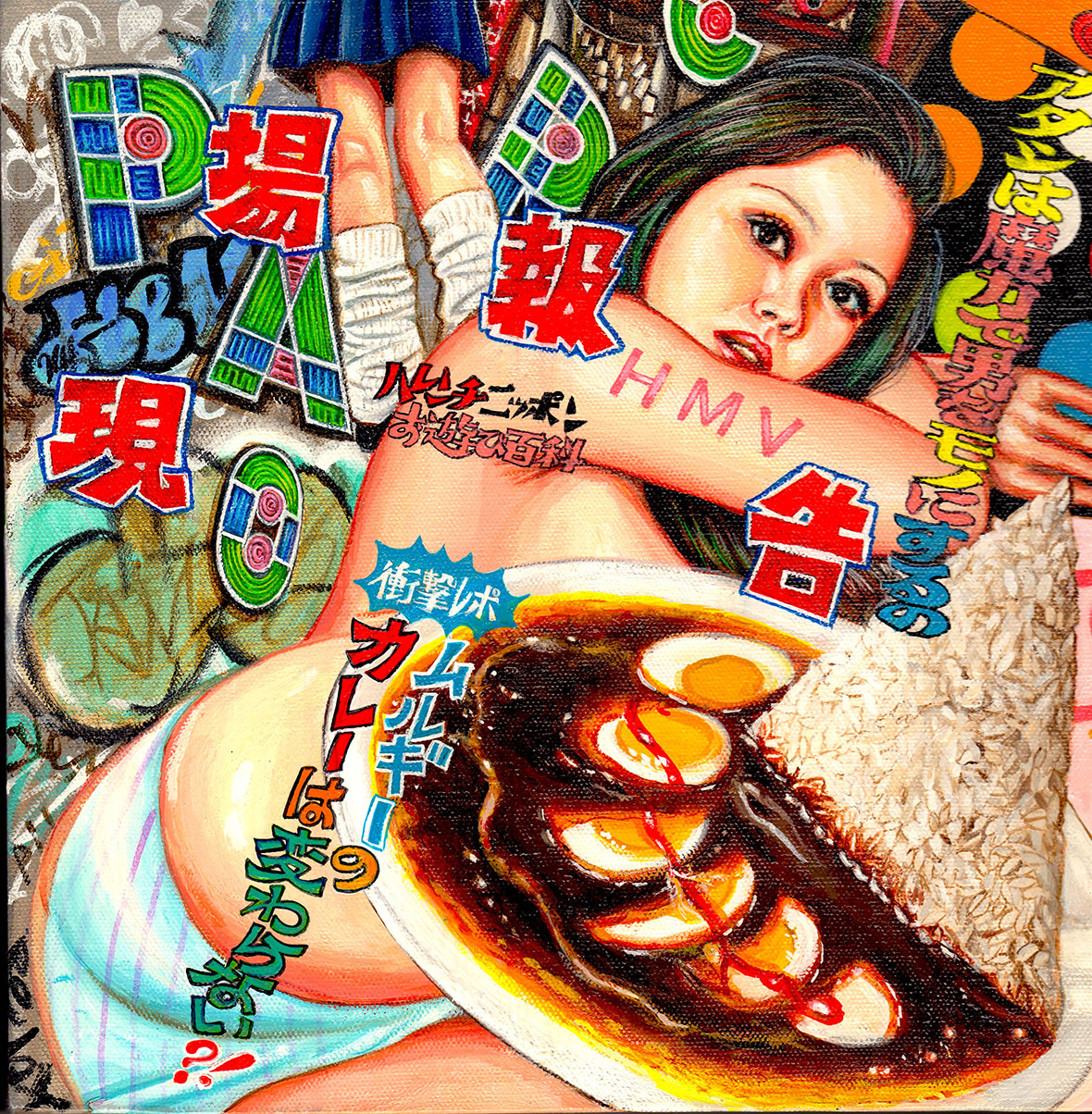
Frequently, Yoshioka establishes an interesting parallel between a man’s desire for women and his appetite. Her women appear associated with food and drinks, like sake sets, sushi, and, perhaps implying a housewife role, vegetables, and packaged food—several times these women are involved in food play.
Occasionally, they are the food, or so it seems from Yoshioka’s depictions. In a few instances, they stick their heads out of sake cups or literally bathe in curry bowls as if ready to (gladly) be devoured. Regarding this association, Yoshioka simply says she “enjoys drawing food as much as she enjoys drawing a woman’s naked body” and that “the sexiness of a woman’s body and food go well together.”
Yoshioka admits her depictions of life and culture during the Showa period are not necessarily accurate. She doesn’t engage in in-depth research and is not interested in the period from a historical perspective. Instead, her inspiration comes from movies and posters, sex advertisements, and other elements that evoke the Showa mood. The rest she paints with her imagination. Sometimes she even inadvertently includes anachronic elements in her illustrations and only finds out when someone points them out.
吉冈里奈频繁地将男人对女人和食物的欲望进行有趣的类比。画中的女性人物常与食物及饮料联系在一起,很多场景都与食物游戏有关。例如,作品中出现的清酒器具或寿司拼盘,又或是蔬菜和包装食品,暗示家庭主妇的身份。
有时,这些女性形象本身就是食物。她们会把头从清酒杯里伸出来,或者在咖喱碗里泡澡,好像随时准备好(心甘情愿地)被吃掉。对于这种关联,里奈说:“我喜欢画食物,就像我喜欢画女性裸体一样——总觉得女性身体和食物画在一起毫无违和感。”
里奈承认她对昭和时期的生活和文化的描述并不一定准确。她对历史并不感冒,有时只是浅尝辄止。她的灵感来自电影、海报、性广告以及其他能唤起昭和印象的元素,剩余的创作统统交给想象力。有时她甚至在作品中无意加入了其他年代的元素,透过旁人的指出,她才猛然意识到。
Yoshioka’s chosen aesthetic is undeniably linked to the sense of escapism from contemporary life. Still, perhaps, her work also bares a sense of reverie that takes her away from her own world and personality. “When I was a student, I was quiet and restrained. I felt inferior. Since painting gives you the freedom to do as you wish, I like to draw pretty girls that are different from me. I think there’s also a longing for and a crush on these pretty girls,” she says about her work.
Yoshioka grew up and is still based in Kawasaki, one of the main cities of the Greater Tokyo Area. She always enjoyed drawing and began attending painting classes when she was three. Creative fields were always her thing, and she later graduated from Tama Art University, majoring in film and photography.
During her studies, she developed a parallel interest in Indian culture, especially religious paintings of deities. After she graduated, she worked part time in an Indian restaurant and eventually embarked on a trip to the country. Amidst local frenzy, one thing caught her eye: “I was overwhelmed by the power of hand-painted movie signboards,” she says. That’s what prompted her to go back to drawing and towards her specific style.
她所塑造的美学流露出一种“逃避现实主义”的色彩。“逃避主义”主张人们逃离现代生活和本我。她这样描述自己的创作动机:“学生时代的我,很安静,很克制,也很自卑。但是画画可以让我随心所欲。我喜欢画那些和我不一样的漂亮女孩。我想,是一种对漂亮女孩的渴望和迷恋在促使我创作。”
吉冈里奈成长于大东京地区的主要城市之一——川崎,她目前仍住在这里。从小喜欢画画的她在三岁时就开始上绘画课,并笃定要从事创意行业。后来,她去了多摩美术大学攻读电影与摄影专业。
学习期间,里奈对印度文化产生兴趣,尤其是印度宗教绘画中对神的描绘。毕业后,她去了一家印度餐馆做兼职,并前往当地旅行。在印度,最让里奈触动的是电影广告牌,这也促使她重新开始画画,完成属于自己的独特风格。

Yoshioka also mentions the work of Tadanori Yokoo as an influence on her work. Yokoo is a prominent graphic designer and a representative artist of the Japanese counterculture. He began his career creating posters and flyers for theater productions. With time, though, he became interested in mystical and psychedelic themes, doing his own travels through India in search of inspiration. His work is pop and colorful, composed mainly of nonsensical collages that make a satirical commentary on Japanese society.
Similarly, Yoshioka’s art can also be seen as a comical critique of Japanese society, notably the place of women in Japan’s patriarchal society and the shufu culture that dictates they have to become housewives and submit to their fathers, husbands, and sons. In her illustrations, Yoshioka playfully twists the power balance in sexual role-playing. Her male characters appear pathetically gawked, lost in perversion and lust, and with the appearance of overworked middle-aged men.
On the other hand, her female characters are exuberant and in control, using their seductiveness to manipulate their male counterparts and get what they want. “It seems humorous that men try to stand on top of women socially, even though they are not as attractive as women. That’s why I always draw attractive women,” she says. Yoshioka sees women’s attractiveness as something powerful and hypnotic—something men lack in nature.
采访中,里奈还提到横尾忠则(Tadanori Yokoo)对她的影响。横尾忠则是一位杰出的平面设计师,也是日本反主流艺术的代表。他的职业生涯始于为戏剧作品创作海报和宣传页。后来,他又对神秘和迷幻主题产生兴趣。为了寻找灵感,他同样也曾前往印度旅行。鲜艳且丰富的色彩是他作品的主要特点,以讽刺日本社会的无厘头拼贴作品为主。
里奈的作品也同样不乏对日本社会的戏谑批判,尤其是针对女性在日本男权社会和主妇文化中的地位的批判——主妇文化要求女性成为家庭主妇,服从于她们的父亲、丈夫和儿子。她俏皮地扭曲着传统的两性权力平衡,画面中的男性角色多为中年男人,因过度劳累而呆滞得可怜,迷失在肉欲横流的变态之中。
而她笔下的女性角色则充满活力和控制欲,她们利用自身的魅惑来操纵男性对手,获得想要的东西。里奈说:“即便男人没有女人那么有吸引力,他们还是会试图在社会层面上凌驾于女人之上,这一点很搞笑。” 她认为女性的吸引力是一种强大的、如催眠般令人失神的东西,这恰是男性本质上所缺乏的特质。
Eroticism in Japanese art precedes the Showa Era by centuries, and it was a part of daily life. During the Edo period, from 1603 to 1867, shunga, a sexually explicit art form printed in hand scrolls, was widely available and appreciated across society. Like the pink films, these erotic depictions represented the sexual relations of ordinary people and were replete with lust, drama, and comedy.
Jump a few centuries, and much has changed. As Japan modernized, sexual repression grew at the same speed. Discussing sex and private matters can now represent huge cultural taboos. In some ways, by illustrating a completely different Japan, Yoshioka also criticizes the fact that Japanese society seems to have gone passionless and repressed.
Yoshioka doesn’t like to define her work. Still, she says it relates to how “people’s feelings and desires were more disclosed in the past than they are today” and that her illustrations are a way to cast light “on feelings of melancholy and desire,” as well as the “strangeness of human beings.”
It’s almost as if Yoshioka is musing on anemoia, or the nostalgia we can feel for a time we barely experienced, to draw a shameless Showa, partly accurate, partly imagined, based on her own interpretation of a bygone era when things were more loose and exciting and when human emotions were more exposed.
日本艺术中情色元素的出现要早于昭和时代几个世纪,情色艺术一度甚至是日本人日常生活的一部分。在江户时代(1603 年至 1867 年),春画(shunga),一种印刷在手卷上的、赤裸裸表现性爱的艺术形式,在社会上被广为传播和欣赏。像桃色电影一样,这些情色作品描绘普通人的性关系,其中充满了欲望、戏剧性和喜剧元素。
王朝兴替,岁月变迁。几百年后,随日本的现代化进程而来的,还有日益加剧的性压抑。时至今日,讨论性和私密话题已然成为文化大忌。从某种意义上来说,吉冈里奈是在通过描绘一个与当今完全不同的日本,批判着日本社会里似乎已经凋零的性激情以及无处不在的压抑。
她不喜欢定义自己的作品,对于创作,她只做了这样的阐述:“相比今日,过去的人们更善于表露感受和欲望。而我的作品正与这一点差异有关,其张扬‘欲望的快感’,又揭示着当代社会人与人之间的‘疏离感’。”
里奈深陷于过去,她怀念着一段几乎没有经历过的时光,然后根据自己的解读,参照历史,通过想象,重构了一个开放的昭和时代——一个氛围更轻松、更令人着迷、人们可以更自由地表露情感的时代。
Like our stories? Follow us on Facebook and Instagram.
Website: www.rina-yoshioka.com
Contributors: Tomas Pinheiro, Lucas Tinoco
Chinese Translation: Yang Young

